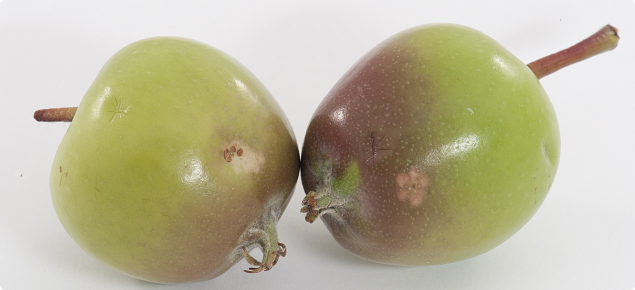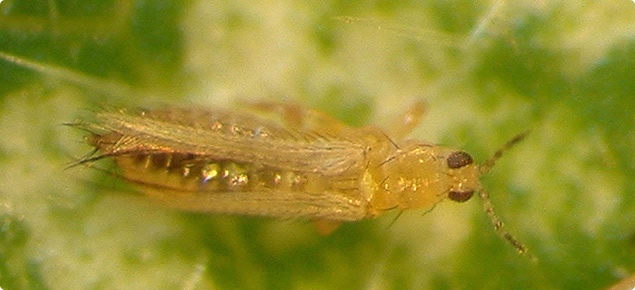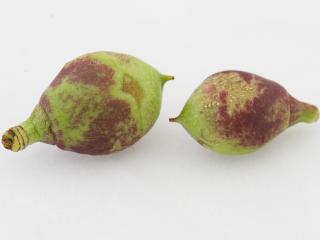Damage symptoms
Early season damage (flowering, fruiting)
- Scarring is caused by female thrips laying eggs into the buds and flowers of plums and nectarines. The larvae hatch and feed on the developing fruit of plums, nectarines, and peaches.
- Pansy spot. In apples, cherries, pears, and plums, oviposition damage causes ‘pansy spot’. The oviposition site becomes covered in scar tissue (<1mm in size), and is surrounded by a larger, pansy-shaped white discoloration. Similar damage has been observed in table grapes and French beans. Apples are particularly susceptible to pansy spot, with damage recorded from both green (Granny Smith) and red varieties (Pink Lady, Red Delicious, Rome Beauty, McIntosh), although some cultivars show no damage at harvest.
- Russeted spot. In pears, egg punctures result in a slightly depressed, russeted spot. At harvest this damage is characterised by russetting, scarring, pitting and/or scarred blotches.
- Dimpling. In plums, apples and cherries, dimples form as a result of differential growth between injured and uninjured tissue surrounding the oviposition site.
Late season damage
This occurs as the fruits ripen and is caused by adults and larvae feeding on the fruit surface, typically when the fruit has coloured.
- Silvering occurs as the fruit ripens and usually occurs in protected areas where thrips shelter, such as between touching fruit, where leaves contact the fruit, and at the stem end.
- Silvering is most obvious on highly coloured varieties of nectarine, and to a lesser extent, on cherries and peaches.
Other damage that may be confused with thrips
During seasons when the shuck remains on the developing fruit for longer and does not split, damage similar to that caused by thrips can occur. This can result in scarring and/or marking around the calyx, which becomes more obvious as the fruit grows in size. This type of damage can be distinguished from that caused by thrips in that there is no scarring or russetting.
A disorder termed russet scab has been reported from prunes in California when rain is heavy during bloom. As a result, there is incomplete development of the waxy layer, resulting in russetting.
Economic damage
Thrips damage can result in fruit being downgraded if it is scarred or russeted, or culled if fruit is misshapen.
Nectarines are most susceptible to thrips damage as the calyx adheres more tightly to developing fruit.




